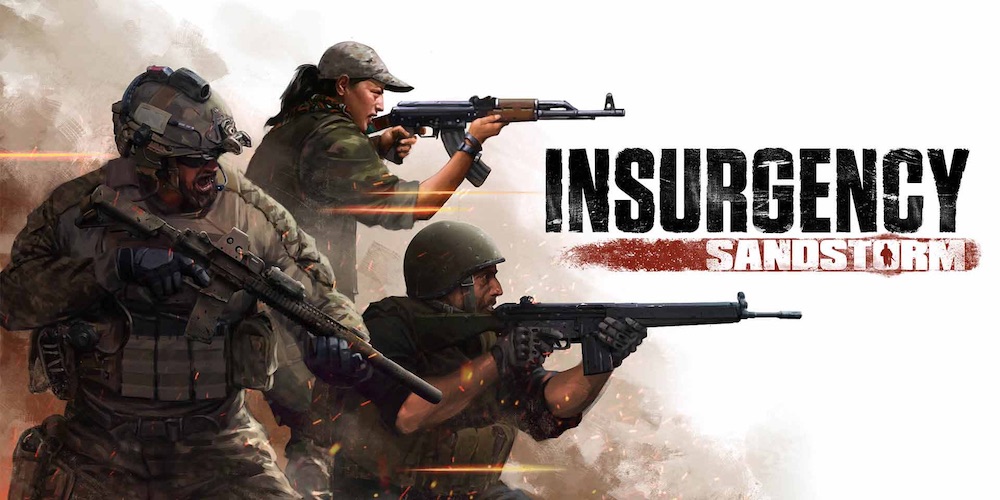
With Insurgency: Sandstorm being the third military shooter I’ve reviewed this holiday season, I think it’s safe to say that I’m now the de facto patron saint for all that is pew pew and “oo-rah” here at GameCloud. With both 800 pound gorillas in Call of Duty and Battlefield now behind us and settling into their familiar rhythms of microtransactions and balance-tweak blunders respectively, some of the great unwashed (aka my adoring public) might be feeling the need for something with just a little more in their never-ending quest to “get some.” Insurgency: Sandstorm has got the goods then if you’re feeling like the old staple franchises aren’t quite intense enough for you, as I can now attest with my recently acquired trembling hands and the thousand-yard stare.
Insurgency started life off as a multiplayer mod for Half-life 2, then eventually a fully standalone game attempting to cater to a crowd for whom the likes of Counter-Strike and Day of Defeat weren’t quite “realistic” enough. Realism, once being the subjective shorthand of insecure, unenlightened nimtards for whom military-themed shooters were the only legitimate form of entertainment besides huffing petrol and headbutting one another, kind of meant this series catered to a small crowd. It’s a shame then, as Insurgency proved the value of aiming for a more realistic game with truly tense firefights and more deliberate pacing. Since the nimtards’ once stern playgrounds of poo-brown colour palettes and hard-man jargon have made the full loop in terms of settings and levels of silliness in other franchises to capture new audiences, it looks like Insurgency is all that’s left.
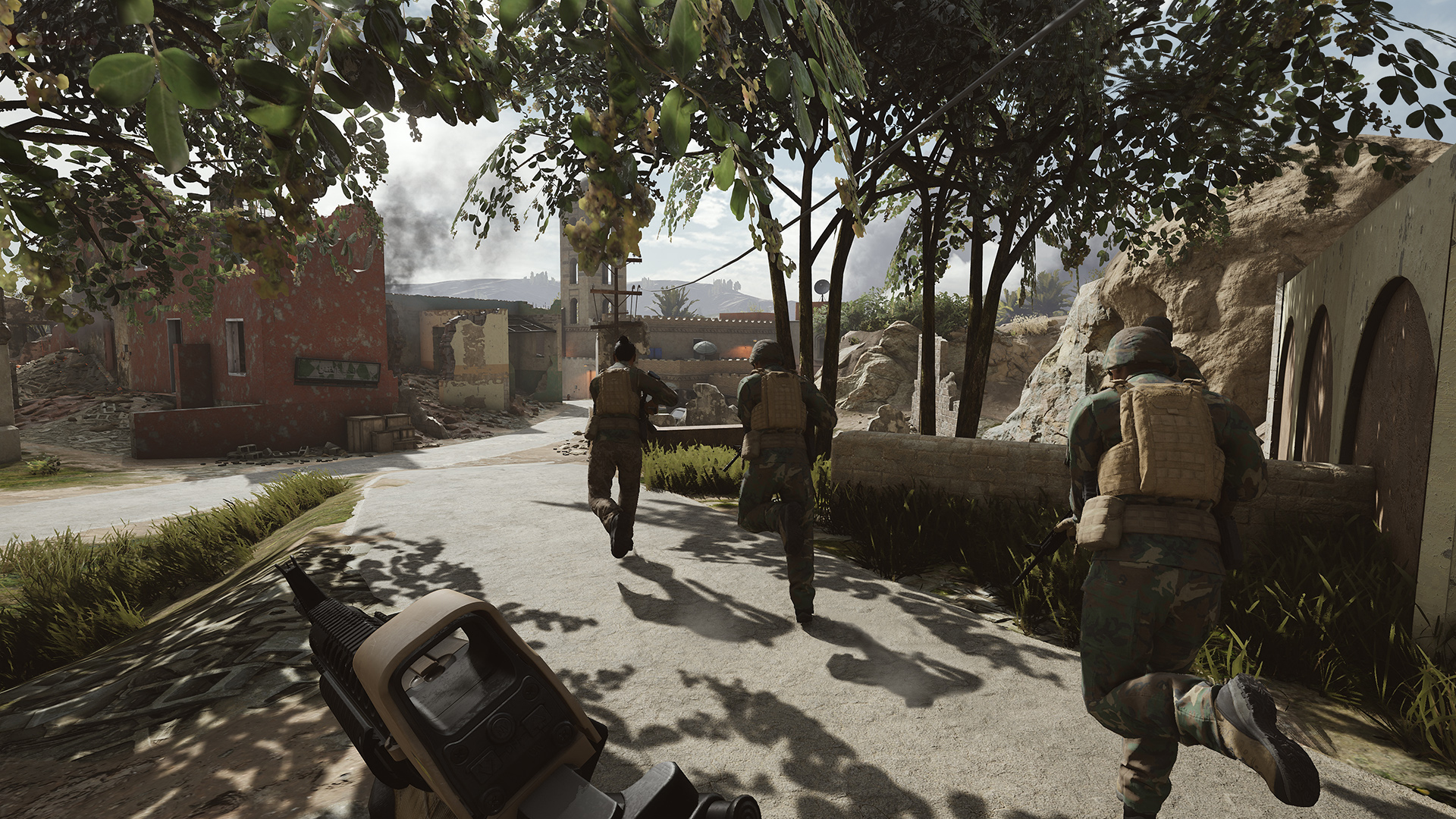
This little mod that could seems poised to gain a new level of popularity thanks to a grand visual and aural overhaul. So what exactly is this game in a nutshell? Sandstorm is an infantry-focused multiplayer shooter that offers the ballistics and pacing of a simulation game like ARMA but packed into smaller-scaled territory control battles that don’t require a doctorate in Strategy and Topography to navigate. It sounds simple to the point of redundancy when I put down on paper like that, but as with all shooters, the devil is in the details, and Sandstorm makes for a damned exciting game even if it doesn’t sound like one.
And yet, it’s sound that is the most crucial detail in Sandstorm, and arguably the most versatile weapon. While listening for footsteps in multiplayer FPSs has been an essential tactical input since the days of Quake, Sandstorm adds a few tactical wrinkles to putting one’s ear to the ground. Firstly, the sound of weapon fire is physically modelled, meaning it stretches and muffles based on distance and the materials through which the sounds are penetrating or bouncing off of. This means you’ll likely be hit by a marksman rifle’s shot well before you hear it, especially if they’re hiding well, and you’ll slowly start learning to place your enemies based on the muffle of their fire.
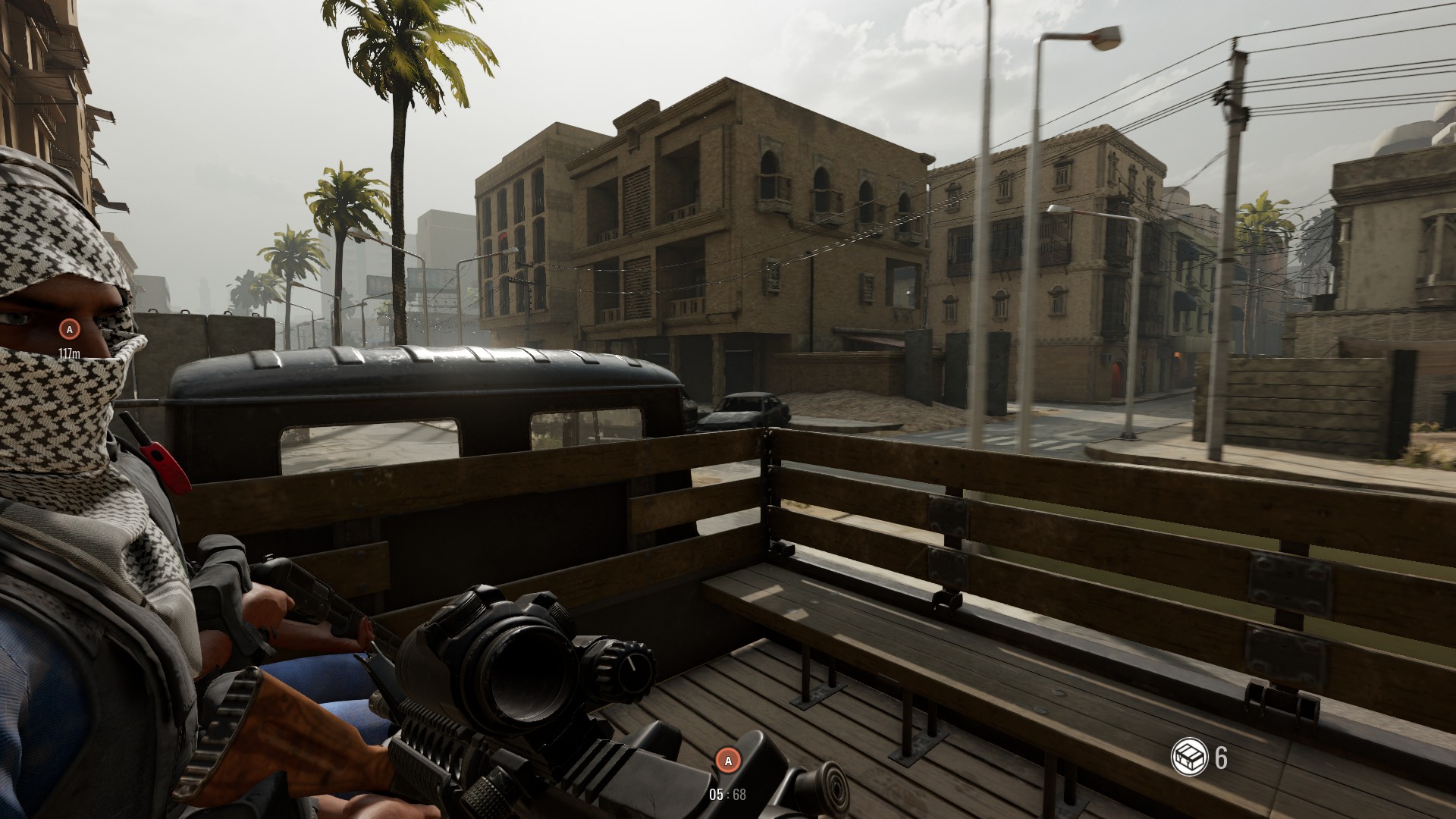
Battle chatter from player avatars play an important role, too. Sprinting, smoke and tear gas will cause avatars to audibly cough, wheeze and complain, which is a terribly weeny thing for hardened warriors to do, but it makes tactical grenades an invaluable tool. Gas and smoke can be countered with the equipping of a gas mask, but it’ll take up precious space that could be used for weaponry. Using your mic to talk to your teammates, too, can give your position away if you’re shouting or blabbering in the wrong place at the wrong time. It’s a positional system, so getting separated from teammates means you won’t be readily able to communicate with them. What all of these seemingly small aural wrinkles feed into is an overall sense of caution and an atmosphere that is most captivating in the quieter moments in anticipation of your opponents’ movements.
The level of tension that the sound system evokes makes it all the more easy to be rattled once firefights break out. All the guns in Sandstorm are snarling, chunky monstrosities, and utterly terrifying to be on the receiving end of for two simple reasons – papier mache and meatbags. The walls all seem papier mache thin when you’re hiding in a building, and your opponents are firing at you, almost all bullets readily penetrate them, tearing sand and your wits apart with them. Bullets drop realistically over a distance, and recoil is massive on most weapons when used in a standing position. Careful observation, patience and planning are needed to make your weapons work most of the time, so don’t forget – you are a meatbag. If you do, you’ll learn this the hard way, repeatedly, as you’ll die from a single shot nearly every time you’re attacked. You have to learn to respect the game’s weapons, as it were, due to their handling and ability to dismember you when you least expect it. That’s not an embellishment, either – guns will take your head off at close range in Sandstorm, and it’s the cold slump of the understated ragdolls that make seem harrowing when you see it happen.
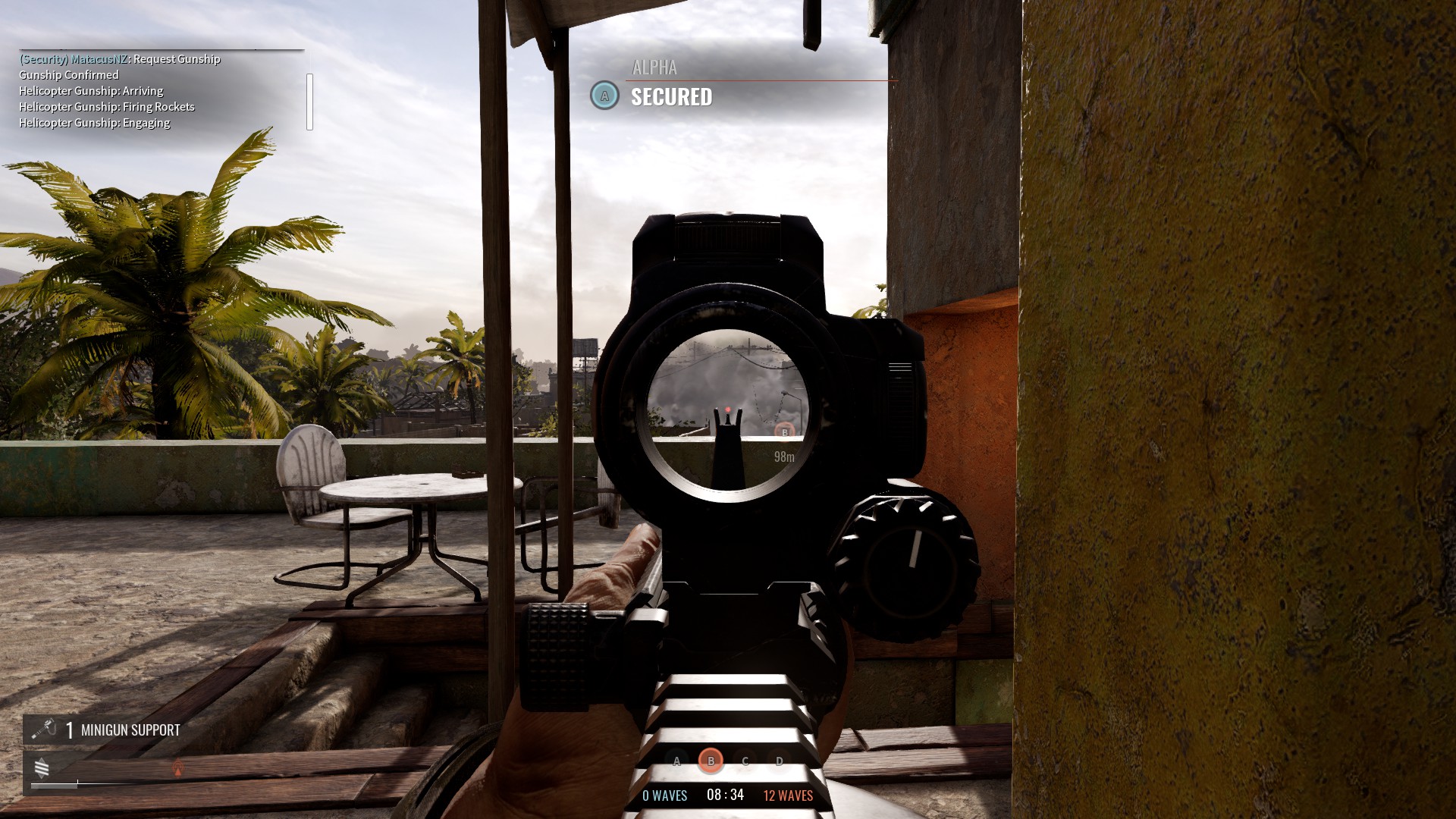
Further to the notion of having to respect the weapons in Sandstorm, all of the reloading and item swap animations aren’t so much slow as they are heavy. Reloading, in particular, has odd quirks to it. For one, there is no magic replacing of bullets into the current clip; if you reload with a few shots still in your clip, they will stay there until you load that same clip again. This little trait can come back and bite you on the ass if you’re a bit too trigger happy, but you can also double tap the reload button to toss away the current mag and quickly load the next, but it means you’ll lose what’s left in the clip. This severe mindset of the basic mechanics carries over into everything, particularly in animations.
Subtle movements like the wobbling of the wrist from side to side when lifting an SMG slightly off to one side with one hand, or the flexing of barrels as they fire shows a level of reverence for firearms in Sandstorm’s instruments of death. Everything takes longer in this game, too, from switching weapons to changing mags and picking up dropped equipment. There also aren’t any hit markers of any kind – the only way to make sure your enemy is dead is to watch their body slump and wait for the text call out. Sandstorm is porn for gun nuts, but for the rest of us it reinforces the fragility of being a meatbag, and the weight of dying so quickly and so easily gives cause to consider your actions more carefully.

Speaking of weight, the amount of equipment you can carry is dictated by it – want to kit out that rifle with foregrips, compensators and a 3x sight? Well, in that case, you won’t be able to bring any sidearms, kevlar or grenades. As for the types of equipment available to you, well, of course, that’s a matter of class, and Sandstorm sure has a lot of them. Besides your typical riflemen, heavy and marksman classes, there’s the explosives guy, the guy who trained the cops in the next town over, oh, and everybody’s boss (the commander) and his bloody cronies (the “observers”). Each class has access to different weapons, and both factions have different weapon sets for their classes, with a small amount of overlap in between. Most behave precisely as they sound, and most of their nuance in play revolves around playing to the strengths of their chosen weapons.
The Commander and Observer classes, on the other hand, are a little more interesting. Commanders can call in various types of support in the form of gunships and ordinance, but they’ll need to be near an observer for them to be able to radio it in. These support calls can swing the tide of a match, but they’re not Call of Duty style harassment that makes outdoor areas unapproachable – they can only focus on a small area or building. Because of how useful support calls can be, the boss and his cronies are prime targets, and coordinated teams with good marksmen can cripple a team with gormless twits calling the shots.

Victories require working together and communicating well, as matches in Sandstorm are all about momentum. Respawns are limited to a number of waves, of which there’ll be a difference depending on whether a team is attacking or defending – attackers have fewer waves than defenders. Downed players can only respawn once a point has been captured, and if all points are captured, the match ends. If a team fails to regain control over a point within the time limit, the team with the most current holdings wins. If a team isn’t working well together, they can be stomped in under a minute. It’s brutal, and yet another reminder that in this game you need to keep your wits about you.
Lastly, Sandstorm has a co-op mode. And it’s possibly even better than the main competitive mode. There are fewer classes to work with, and you’ll have fewer players on your team, but your AI enemies grossly outnumber you. They’re no dummies either and will flank, gas you and shoot you through walls and floors if you make too much noise. And because spawning works the same way as they do in the competitive mode, co-op is as tense as a wrestler’s gooch on game day, too. Though it’s not a casual mode in any sense of the word, it is the best place to begin to enjoy Sandstorm, and I for one can wait to see it expand and evolve. I have complaints, but they feel trivial when I think about how good the rest of Sandstorm is. And yet, I have to mention that the lack of the initially planned campaign makes Sandstorm seems a little bare with its handful of levels and naught-but-two gameplay modes. That, and the customisation is kind of redundant. With the extensive focus on realism, all of the hundreds of custom uniform options are so trivially different in even up close appearance I barely cared to spend any of my credits acquired from ranking up on anything other than a boonie hat – but in the end, everyone looks pretty brown down the end of your sights.
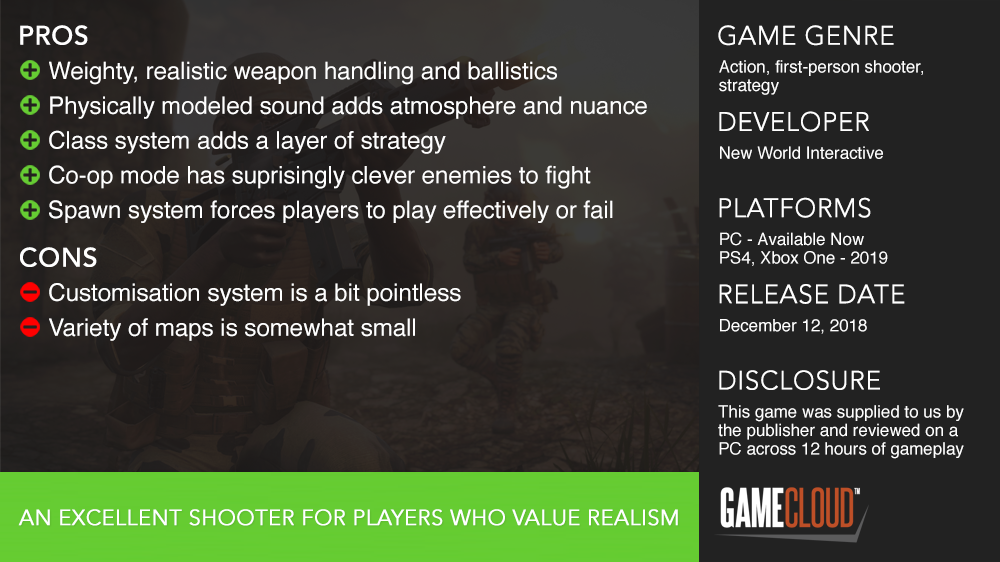
Insurgency: Sandstorm aims for the hardcore in a way that’s hard not to appreciate. The frighteningly realistic weaponry, excellent sound design and mechanical reinforcement of communication and strategy make it a winner for those who may be tired of the more whimsical and approachable shooter staples available today. While it may currently be a bit thin on the ground in the way of actual maps to play on, there’s plenty of meat on Sandstorm’s PTSD-addled bones, with tight, tactical combat that’ll have your nerves shot but your mind sharp by the end of each match.











